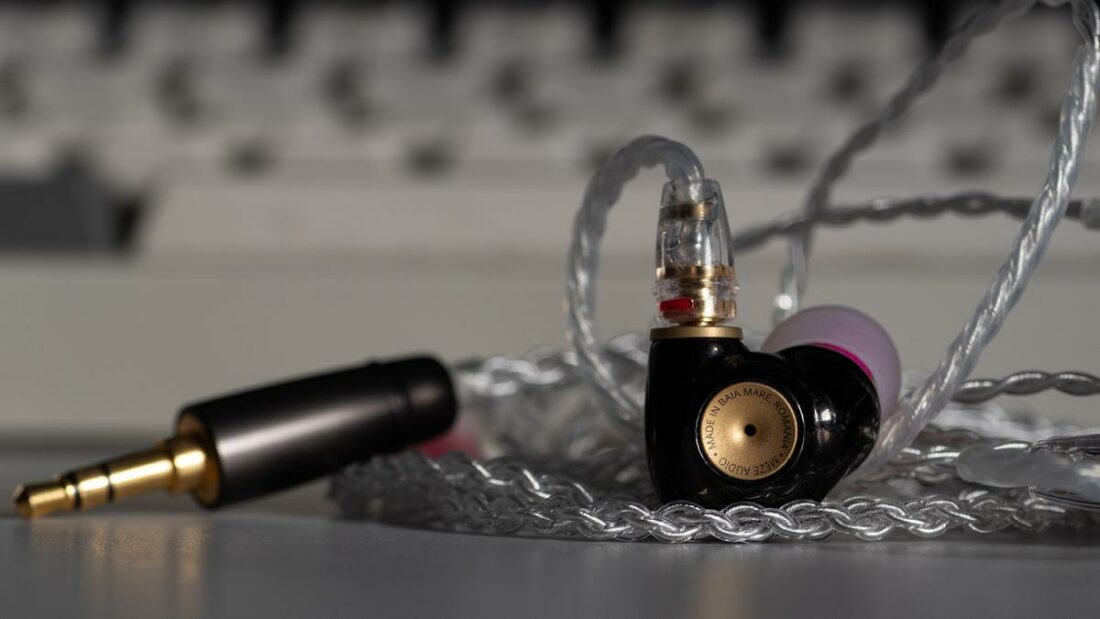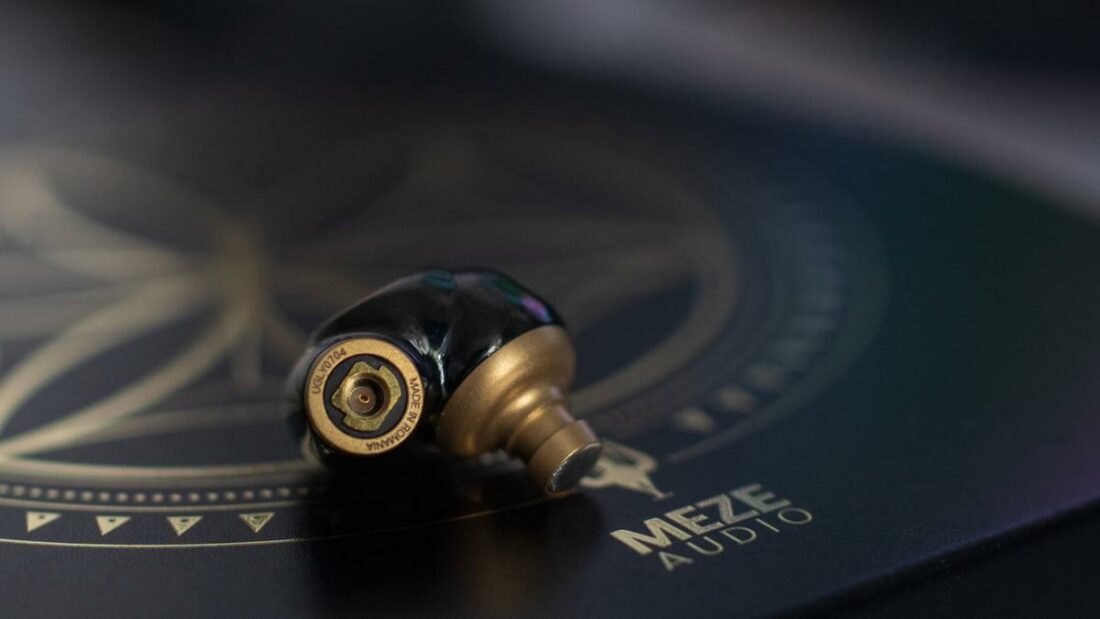Meze Audio’s flagship single-dynamic driver IEMs have an exceptional build, a timeless design, and perplexing tuning choices.
Meze Audio is known for its exquisite build and unique design language. The brand’s tuning focuses more on “fun listening” than absolute neutrality, which is rare these days as more companies are veering towards hitting a specific tuning target.
I think there is room for all kinds of sound signatures, and Meze’s insistence on doing their own thing is something I appreciate.
- Exceptional design and build
- Very comfortable fit
- Punchy, textured bass response
- Warm, lush male vocals
- Good staging and imaging
- A balanced cable should’ve been included or offered as an option during purchase
- Recessed upper-mids tend to dampen soaring vocals
- Macrodynamic punch could’ve been better
- Abrupt treble-peak near 6kHz may cause fatigue for sensitive listeners
- Not the most resolving for the price
Enter the Meze Advar, their latest pair of flagship IEMs. Given the recent resurgence in single-dynamic driver IEMs, the Advar faces stiff competition from new and established brands alike.
Did Meze manage to create something unique, or are the Advar just another face in the crowd? Read on.
Technical Specifications
- Form: IEM
- Drivers: 1 x Dynamic driver
- Impedance (Ohm): 31 Ohm
- Sensitivity (dB): 111 dB/mW
- Frequency Response (Hz): 10 Hz – 30 kHz
- Removable Cable: Y
- Source Jack: 3.5mm
- Cup/Shell Jack: MMCX
Packaging
Meze paid a lot of attention to the artwork on the packaging.
“The outer circles are similar to our representation of the “hora,” a traditional dance that carries a cosmic symbolism to Romanians – the circle of people united in hand represents a dance of the planets around the Sun, a magical union of the tangible with the spiritual.
In the center of the circle, the Sun itself. Protector against darkness, a source of light that enables all things to thrive and grow.” – Meze Audio
It all feels coherent with the design language of the Advar, and that’s a cool little detail. The unboxing experience itself is nothing special, however. The IEMs are placed in foam cutouts, and the other accessories are placed underneath.

In the box
- Meze Advar IEMs
- 5 pairs (SS, S, M, L, LL) of Final E-type ear tips
- Cleaning tool
- PU leather carrying case
- MMCX removal tool
- 1x MMCX silver-plated copper, 1.2m cable (3.5mm termination)
The accessories are all high quality, especially the MMCX removal tool, which I find to be better than the one Final Audio offers. Check out this video if you are unsure how to use the tool.

The carrying case is slightly oversized with two extra pouches inside. You can keep the cleaning tool, extra tips, and even the MMCX tool in them.

As for the ear tips, the E-type tips are some of my favorites. They provide an excellent seal and tend to decrease shoutiness in most IEMs.
Finally, the cable. Meze usually makes good aftermarket cables, and the stock cable of the Advar is good enough not to look for replacements. The sheathing is on the stiff side, so not the most pliable, but this is a nitpick.
I would have liked the option to select a balanced cable with the Advar during the purchase process. Even better would be bundling one in the package. At the near USD $700 pricing, it’s expected in the current market.

Design
In a single word, exceptional.
The meticulous attention to detail alludes to the sheer excellence of the craftsmanship. Stainless steel housing polished to have an enamel-like sheen.

The nozzle has a vent near the base, and a larger, more prominent vent can be seen on the back. There is laser-etched writing all around the IEMs, mostly flaunting Meze’s pride in making the IEMs in-house in Romania.

The nozzle is a bit on the short side, so finding tips to get a good seal can be an issue for some.
Comfort and isolation
Once you find the right ear tips, the Advar offer a very snug fit.
Unfortunately, the short nozzle length does not help in stabilizing the fit. The stock cable is also thin, so they tend to fall out of the ear if you exercise while wearing these IEMs.

Isolation is below average due to the vent right behind the shells and the other near the nozzle.
Internals
Meze utilizes a single 10.2mm dynamic driver in the Advar. That’s all we get to know about the driver, as Meze chose not to disclose any further information.
This is somewhat odd given they are usually very open about the specifics of the driver arrangements, e.g., the Meze Rai Penta. Nonetheless, the internals do not matter as much as sound quality, so let’s get to that.
Meze Advar Sound
Meze Advar have warm mids counter-balanced by lower-treble prominence.
Additionally, the upper-midrange is recessed. These tuning choices result in a signature that is good at spreading out instruments but lacks focus on vocals or any specific instruments.

Bass
Bass texture is good, while bass speed is above-average. Sub-bass rumble is soft and lacks the physicality of some of their peers.
Fast basslines are not delineated as well as I would prefer since some of the competing IEMs do better in that regard. The sense of “slam” is also a tad softened, though the Advar does better here than the all-BA IEMs in this price bracket.
Midrange
Light snare hits sound a bit dampened, but heavy hits do not. Male vocals sound correct for the most part, with baritone vocals and grand pianos taking on a thicker, denser tone.
If you prefer a forward vocal representation, the Advar will disappoint. The relatively recessed upper-mids (2-3kHz area) help in avoiding shout. Unfortunately, this results in female vocals sounding somewhat “stuffy”, as if they are signing from a row behind.
The lack of bite in guitar riffs and acoustic guitars makes certain songs sound bland. Rock and metal listeners might not get the most engaging presentation on the Advar.
Treble
The upper-mid recession acts as a double-edged sword since the listener’s focus gets centered near the lower-treble peak. Since we are very sensitive between 3-6kHz regions, the treble peak around 6kHz can get grating and sibilant.
As a result, fatigue sets in, and brass instruments take on a somewhat metallic timbre. Moreover, resonances are more pronounced than the initial “attack,” resulting in an ethereal, sometimes “tinny” representation of instruments.
Upper-treble extension could be better, as the solitary peak near 14kHz does not do much to inject a sense of “airiness.”
Soundstage and imaging
Staging has good width, but height and depth are lacking. Part of the width perception can be attributed to the reserved upper-midrange.
Imaging is about average for the price class, with precise cardinal and somewhat diffused ordinal positioning. Layering and separation are very good, especially for a single dynamic driver.
Dynamics and speed
Macrodynamic punch is good in the bass region, so bass drops sound physical and dense. On the other hand, crescendos do not have the sense of grandeur that I expect due to the lack of upper-treble extension.
The driver speed is above average for a dynamic driver, but there are faster drivers at this price point.
Effect of Ear Tips on the Sound
As I shared my impressions of the Advar on the respective head-fi thread, some members pointed out that tip-rolling (i.e., changing to a different set of ear tips) might solve the treble peakiness issue.
The most recommended ear tips were the JVC Spiral Dots, which I already had in my collection. Changing the ear tips brought some interesting results, as seen in the graph.

In essence, the lower-treble peak was shifted further down the right. I repeated the measurements via re-seating the IEMs, and it yielded the same results, so the stock E-type tips are probably not the best fit if you do not like awkward brightness.
That being said, the treble peak merely shifted the position; it never quite subsided. So changing the tips does not really solve the tuning issues of the Advar and merely moves it to another position.
Comparisons
Vs Dunu Zen Pro
Dunu’s Zen Pro are priced slightly higher than the Meze Advar but has a similar single dynamic driver configuration.
In terms of build quality, I think both of these IEMs are excellent. However, the nod goes to Meze for aesthetics. Regarding accessories, Dunu supplies a modular cable and a much wider selection of ear tips, so Meze falls behind on this aspect.

As for the sound, Dunu takes on a more neutral approach in tuning, with appropriate pinna-gain (emphasis on the upper-midrange frequencies) and a more reserved bass shelf. The treble is also noticeably more extended on the Zen Pro with no glaring lower-treble peak.
The soundstage has better depth and height on the Zen Pro, and vocals and instruments have a more tonally correct presentation. Imaging is also more precise on the Zen Pro, and the driver is noticeably faster.
For me, the Zen Pro are overall better than the Meze Advar, as long as you are looking for a neutral-ish tuning. If you truly need warmth and a laid-back presentation, the Advar are closer to that target, even though the lower-treble peak is not what I’d call relaxing.
Where to Buy
Conclusion
Meze Advar are works of art, a tantalizing showcase of modern industrial design.
Sadly, the tuning is just too spicy for me to handle. Listening to the Advar is relaxing and pleasant until the treble comes in. So I am left with mixed feelings, a sense of dissonance, and a bitter aftertaste.
If you can handle brightness but still want something laid-back in the mids, give the Advar a shot. They might just be up your alley. For the rest, there probably are greener pastures.

This review shows you just how subjective audio reviews are. I just bought these and am blown away by how good they sound. I would give these 5 stars easily. I think Meze got it right. As they say though, different strokes for different folks.
Hi, I’m glad that you are enjoying the Advar. I am very sensitive to the lower-treble peak in the Advar, so I could not listen to them for long while I had them.
However, as mentioned in the review, if that peak isn’t an issue, they are quite a relaxing and laid-back listen.
I have owned this set for about 6 months and absolutely love them. Whatever Meze did with the tuning on them I find the timbre of distorted guitars such as on Iron Maiden or AC/DC to be the best i’ve ever heard. They are a joy for metal.
For me the cymbals and hi-hats were a bit too distracting and at times had this piercing undertone. Lamb of God’s Ruin, for example, was fatiguing after the drum-fill around the end.